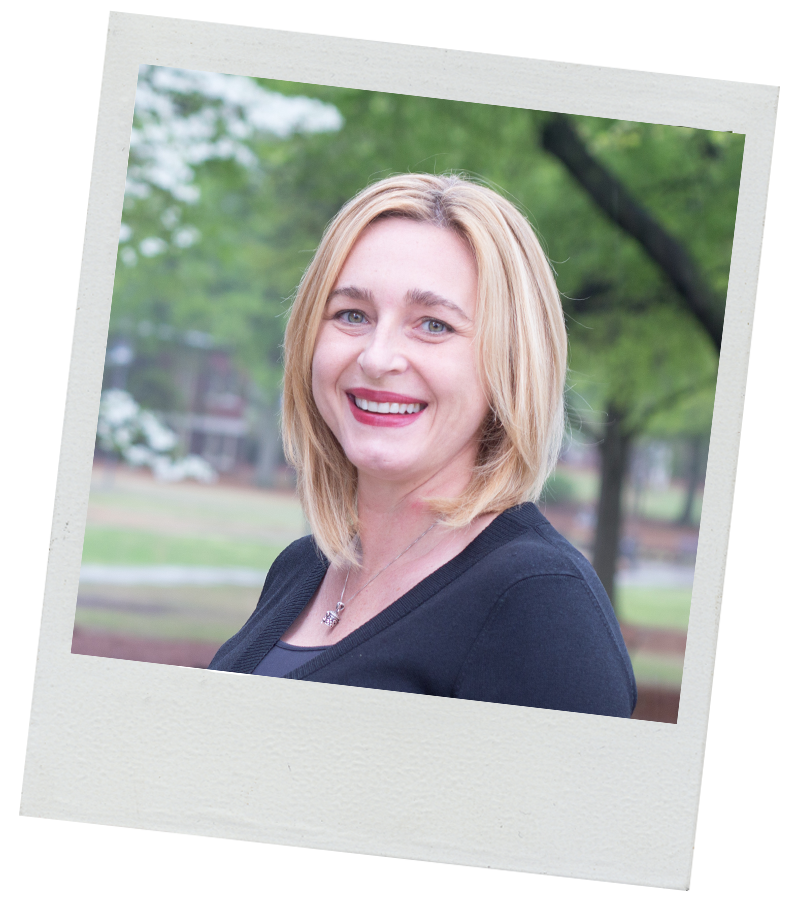#husITa18/#SWSD2018: Sustaining lifelong learning through the use of Technology-Mediated Professional Learning Networks
On Friday July 6, 2018 at 3:15 PM in the Exhibition Hall at the 2018 International Social Work, Education & Social Development Conference, Melanie Sage, Nancy J. Smyth, Jonathan Singer, and I are presenting a poster about how social workers can use technology for career-long learning, specifically by creating a Professional Learning Network (PLN).
Simply stated, PLNs employ, within an online environment, the same strategy that social work professionals have used for centuries: the practice of connecting to people who share interests and can learn from each other. PLNs are a well-established practice in the field of education (Richardson & Manacebelli, 2011). The term comes from the educational technology learning communities and has its origins in Connectivism, a learning theory developed by George Siemens (2005) to explain how network-based learning occurs in the digital age. Specifically, Connectivism suggests that learning is the process of connecting sources of information together across networks, shifting learning from an individual process to a community effort. Thus, learning includes the skills of managing the flow of information, determining what is and is not useful information, and maintaining connections with others to facilitate on-going learning (Siemens, 2005). All of these skills are developed and applied with a PLN.
We are all big fans of PLNs, and have been sharing the practice with the social work community in the US for over a year now. Nancy, Melanie and I introduced the idea of professional learning networks (PLN) to a packed room of social workers at Social Work Distance Education Conference in April 2017, and have highlighted the practice in our upcoming book with Council on Social Work Education (CSWE) Press – Teaching Social Work with Digital Technology. In October 2017, the three of us along with Jonathan shared tips and tricks for setting up a PLN at CSWE’s Annual Program Meeting. Finally, Melanie and I wrote an article for Social Work Today about PLNs was published in March.
All of us also have our own PLN that we actively employ and nurture for our own professional learning. In the following, we each describe our own PLN:
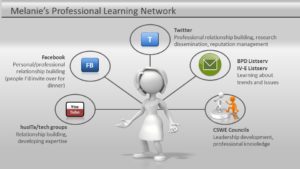 Melanie’s PLN: My goal is to build professional relationships around my scholarships interests, and to model positive technology – use for my peers. My PLN includes:
Melanie’s PLN: My goal is to build professional relationships around my scholarships interests, and to model positive technology – use for my peers. My PLN includes:
– husITa and other technology groups: I am a board member of husITa and active with other tech groups. I follow all of them via different social media platforms and share links to technology related content.
– Facebook: I participate in several closed professional social work & technology groups on Facebook for professional reasons, but I mostly use FB to deepen my connections with colleagues and friends.
– Twitter: This is my go-to-app for initial networking as it is easy to find people, quickly learn about their interests, and engage with short posts (under 240 characters).
– Listservs: I belong to several email-based listservs where I can learn about trends and share my own research.
– CSWE Councils: I am a member of a CSWE Council and here is where I work to connect my in-person network with my digital network, by talking to others about how leaders can use social media to connect and share information.
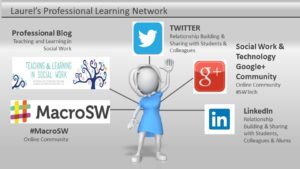 Laurel’s PLN: Because my primary research interest is social work education (how to improve learning outcomes for students and practicing social workers), my goal is to meet other social work educators and practitioners as well as share information about evidence-informed teaching and learning. My PLN includes:
Laurel’s PLN: Because my primary research interest is social work education (how to improve learning outcomes for students and practicing social workers), my goal is to meet other social work educators and practitioners as well as share information about evidence-informed teaching and learning. My PLN includes:
– #MacroSW.com: This is an online community of social workers who host a weekly Twitter chat, which is a great way to meet people from around the US who are interested in macro-level social work topics.
– Professional Blog: I host the Teaching & Learning in Social Work blog, where I write about the scholarship of teaching and learning, especially related to technology.
– Twitter: This is my primary networking platform, and I actively use it at social work conferences to meet people and keep up with all the sessions.
– Google+ #swtech Community: Jonathan created this online community, which includes over 1000 social workers interested in all things tech.
– LinkedIn: Because I use Facebook for personal connections, LinkedIn is my go-to platform for connecting with social work students.
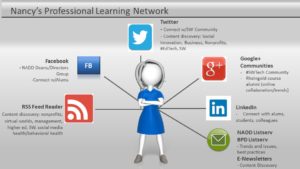 Nancy’s PLN: I use my PLN to stay on top of emerging trends in social work, technology and social innovation. I use several social technologies to support my PLN:
Nancy’s PLN: I use my PLN to stay on top of emerging trends in social work, technology and social innovation. I use several social technologies to support my PLN:
– RSS Feed Reader: This tool helps me to discover and manage content across my varied interests.
– Facebook: I am a member of several professional groups and find Facebook a great way to connect with the UB social work alumni.
– Twitter: I meet a lot of social workers on Twitter and have a public list of over 1200 social workers from around the globe. Anyone can follow this list.
– Google+ Communities: This has been a great space of learning for me as I am a member of Howard Rheingold’s virtual community.
– LinkedIn: Like Facebook, this is great way to connect with alumni.
– Listservs: I subscribe to several social work related listservs and e-newsletters.
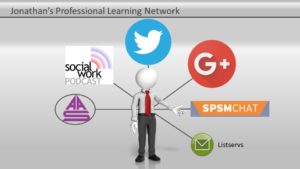 Jonathan’s PLN: I use my PLN to support and promote scholarship dissemination as well as to connect with colleagues – around suicide intervention and technology.
Jonathan’s PLN: I use my PLN to support and promote scholarship dissemination as well as to connect with colleagues – around suicide intervention and technology.
– Google + SW Tech community: I set up this online community for information sharing on tech-related issues, to keep up-to-date on colleague’s scholarship, and discover opportunities for collaboration.
– Twitter: I follow a lot of hashtags on twitter. I mostly monitor #suicide-related tweets, but also keeping up with #MacroSW and #SWTech.
– SPSMChat: I am an occasional guest and regular participant in this weekly chat, through the Twitter chat, a FB Messenger group, and a live hangout.
– American Association of Suicidology: This is one of my professional organization so I subscribe to their listserv, serve on the Executive Board, and actively engage with their social media presence.
– Social Work Podcast: I founded this podcast so I get to talk to the most interesting people in the profession.
– Listservs: I subscribe to several listservs and appreciate the insight and resources.
At our poster session, we will be talking about the mechanics, advantages and disadvantages of establishing a PLN, and guide participants through questions to contemplate for creating their own PLNs.
One resources we will be sharing is our Professional Learning Network (PLN) Worksheet, which takes a social worker through the steps of creating their own PLN. You can get your own copy here: https://tinyurl.com/PLNWorksheet
You can access a copy of our poster here: https://tinyurl.com/PLNPoster
Here is our conference abstract:
Competent and ethical social work practice requires practitioners, educators and students to be lifelong learners who stay up-to-date and share information about current news, practice knowledge and the latest research findings (Council on Social Work Education, 2015; Jivanjee, Pendell, Nissen, & Goodluck, 2015; National Association of Social Workers, 2008). One robust strategy is connecting with a network of people who share interests and information that can advance professional knowledge, skills and values. This type of network is well-established in the field of education (Richardson & Manacebelli, 2012) and is commonly referred to as a Professional Learning Network (PLN). It is seldom discussed in the human services literature as a strategy to sustain professional connections and promote learning. The global reach of PLNs makes it easy, for the very first time in history, for human service professionals to think globally and act locally. In this workshop, participants will learn about the mechanics, advantages and disadvantages of establishing a professional learning networks (PLN). They will work through an examination of their own professional learning needs using a structured worksheet and facilitated guidance, and identify ways that a PLN would satisfy their own sustained professional learning. Presenters will also share ways that a PLN can be structured as an assignment to support the sustained professional learning of students.
References:
Council on Social Work Education. (2015). Educational Policy and Accreditation Standards. Washington, DC: Author.
Jivanjee, P., Pendell, K., Nissen, L., & Goodluck, C. (2015). Lifelong Learning in Social Work: A Qualitative Exploration with Practitioners, Students, and Field Instructors. Advances in Social Work, 16(2), 260–275. https://doi.org/10.18060/18407
Hitchcock, L. I., & Sage, M. (2018). Professional Learning Networks for Social Workers in the Digital Age. Social Work Today, 18(2), 22–23. Retrieved from: http://www.socialworktoday.com/archive/MA18p22.shtml
National Association of Social Workers. (2008). Code of Ethics of the National Association of Social Workers. Retrieved from https://www.socialworkers.org/pubs/code/code.asp
Richardson, W., & Mancabelli, R. (2011). Personal Learning Networks: Using the Power of Connections to Transform Education (3rd edition). Bloomington, IN: Solution Tree Press.
Siemens, G. (2005). Connectivism: A learning theory for the digital age. International Journal of Instructional Technology and Distance Learning, 2(1). Retrieved from http://www.itdl.org/Journal/Jan_05/article01.htm
How to cite this blog post:
Sage, M., Hitchcock, L. I., Smyth, N.J. &. Singer, J. (2018, July 6). #husITa18/#SWSD2018: Sustaining lifelong learning through the use of Technology-Mediated Professional Learning Networks [Blog post]. Retrieved from: https://laureliversonhitchcock.org/2018/07/06/husita18-swsd2018-sustaining-lifelong-learning-through-the-use-of-technology-mediated-professional-learning-networks/


